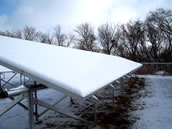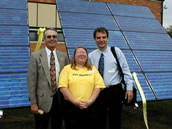Natural Environment
We are infinitely linked to the environment around us. We rely on the landscape for food and water; we harvest and utilize the Earth’s resources for fuel and product materials. We also find joy in recreation and relaxation at the places of natural beauty, the places we have left untouched and protected. With the threat of global climate change upon us, there is more urgency to understand our impact on the environment and the species that inhabit it. As our knowledge of the natural environment grows we will be better prepared to solve the complex problems that the world will face.
Renewable energy is at the interface of the natural and man-made world. This provides a unique opportunity to teach students about natural and ecological processes, such as photosynthesis, the water cycle and food chains. Although, there may seem to be a juxtaposition between a solar panel or wind turbine and a forest or prairie, there are many similarities and overlapping topics. Where will you make the connection?
Below are some helpful links to help you develop new ideas on teaching environmental topics and making the connection to renewable energy:
- The Nature Conservancy is an international conservation organization. They are working to protect natural areas in Illinois at Nachusa Grasslands, Kankakee Sands, Midewin National Tallgrass Prairie and many more. Visit their Nature Works Everywhere site for lesson plans and ideas on how to integrate renewable energy and the natural environment into your classroom.
- Chicago Wilderness is an alliance of organizations, corporations, government agencies and non-profits that collaborate to restore local nature by protecting land and water. Visit the Chicago Wilderness site to learn about the No Child Left Inside initiative. Then go explore the Places to Visit.
- The U.S. EPA provides useful teacher resources for environmental topics. Many of these topics, especially those related to Climate Change, Ecology and Energy will be relevant to the study of your renewable energy installation.
- ICECF's PV for Nature/Welcome Centers program allows nature/ welcome centers owned by park districts, forest preserves, and other 501 (c)(3) non-profit organizations preserving natural areas in Illinois to offset their electricity use and expand their education tools to sustainable energy practices.
- The Illinois Clean Energy Community Foundation also awards grants in Natural Areas focusing on land acquisition. Here you can learn more about this program and the areas that have been protected.
- Climate Cycle helps students and teachers understand the links between energy and the environment through outdoor activities and renewable energy installations at schools throughout Chicagoland.


